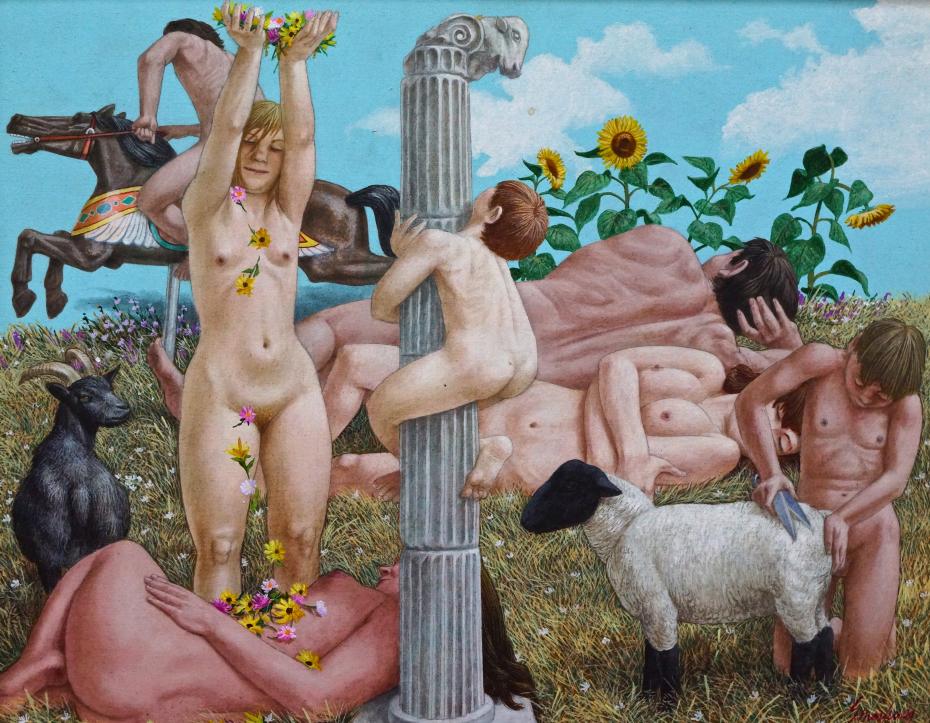September / Autumnal Equinox / Virgo the Virgin
Months of the Year Series – an introduction:
Vincent Smarkusz appears to have painted his “months of the year” series with an annual cycle of mood in mind, depicting its phases as an emergence of consciousness into full wakefulness which then returns to sleep - as a series of dreams within the dream of life. They are all created in his magic-realism style of interpreting life through the imagination of dreams. Recent research has determined dreams to be more visually literal than symbolic, and Smarkusz uses both modes of meaning. He uses the images of familiar objects and subjects that have meaning to the dreamer (himself individually and his viewers collectively) which capture the essence of some human or personal issue, as well as classic Freudian and other traditional symbolism. The word month is derived from the Old English word mona which means moon, and from the Latin mensis, referring to the moon's phases as the measure of time - both have connotations with mood, mind and dreaming. In Latin, annual comes from annulus which means a ring or circle. A more complete interpretation of the series as a whole, including the importance of understanding his entire body of work through the identification of his most frequently used "dream themes and forms", will be conducted at the end of Interpreting “December”.
The artist begins with a mystical series of three compositions representing winter, from which a more natural series of three emerges as spring. The year blossoms into three paintings capturing the social imagery of summer, then becomes more mysterious through fall. The year ends in December as it began in January, with the most dreamlike images of all. Vincent combines this human cycle of perceptual mood with the natural transitions of the Earth in a kind of figure-ground relationship. Much like the seasonal rise and fall of growth in a garden, when plants awaken from winter dormancy to flourish in the summer sun, cross fertilize and go to seed, then withdraw their energy back into the ground – so too does human activity rise and fall between internal and external modes of experience and expression. Each three month season is portrayed differently as the entire series waxes and wanes in an annual rhythm.
Smarkusz was a modern conceptual artist who celebrated tradition, both ancient and modern. One of his many styles of painting was as a new-age magic-realist who sought to unify the old with the new, the simple with the complex, and the insignificant with the magnificent. In his months of the year series, he represents each month with a common holiday or activity special to it. Most of these events have old or ancient origins in western culture, with themes that are embedded deeply in the collective consciousness, and subconscious mind of the viewer. He then relates those themes with ancient practices and astronomical events such as the Zodiac, celestial solstices and equinoxes. In so doing, he created hybrid images of simple, natural and social themes infused with ideas of spiritual significance. By illustrating a special day in each month of each season of the year, and combining it with greater timeless truths, he endeavored to unify mundane reality with a more profound existence. Vincent himself was a dualist - he was a mystical artist enamored with metaphysical patterns, while at the same time he was simply a talented man in love with expressing his views on human nature - through color, form and symbolism.
"September" represents the end of summer and the beginning of autumn; the end of childhood and the beginning of adulthood; the end of parenthood and the beginning of another cycle around the Carousel of Life. In the center of this circulating composition stands a column which symbolizes the ascent of the individual, the family, and all of humanity as we ascend together through generations of biological, social and spiritual time.
On the most literal human level, it is the story of a virgin (Virgo) patiently awaiting the arrival of her lover, with whom she will bear a son. Together they will raise him as parents, then watch him leave when he is grown, in search of his own life and love. It begins with the most basic biological event in the generational cycle of human family as sex between a girl and a boy - as an instinctual act of self preservation, through joining and birth. The artist then reveals more depth and complexity to the story as it evolves into the social bonding of a man and a woman maturing as nurturing parents, with simple human imagery arranged metaphorically to tell the story. By extension, the conceptual momentum of this cyclical pattern then continues to fruition as the story concludes with the most mature form of love, symbolically represented as letting go and spiritual release - as a conscious act of self-sacrifice through separation and death. This is the most final event in the generational cycle of human family on Earth, as the individual returns to the sources of his/her existence. Meanwhile, the newest generation of young adults dream of their own love, life, and liberation once more, and another child is born to ascend again.
As we will see, the artist uses simple visual pattern, natural representation and deep symbolism to depict these basic human experiences as the paradox of an endlessly cyclical path towards a final puposeful goal.
The month of September is transitional, located at the end of the third and beginning of the fourth seasons of summer and fall - three quarters of the way through the year. Also, three quarters of the way through September itself, between the third and fourth weeks of the month, the Autumnal Equinox occurs - the precise astronomical moment when summer becomes fall, and when the day is exactly half daylight and half darkness. These proportions: three of four quarters, within two halves of one whole - are literally embodied in the structural composition and movement of the piece. In addition to being the actual visual structure, these proportions symbolically represent the way in which beginnings overlap endings, in a duality that turns as one paradoxical progression, in a fractal hierarchy of layers.
Smarkusz appears to superimpose astrological transitions which occur at the end of the third week of each month, over seasonal transitions that occur at the end of the third week of the third month of each season, over the annual cycle of nature which transitions at the end of the third season of each year when it goes to seed. As such, the end and beginning of each cycle occurs three quarters of the way through: each month with the Zodiac; each season at the Solstice or Equinox; each year by “going to seed” as illustrated in “September”; and each lifetime (also illustrated), at the end of the third and the beginning of the fourth generations of family - when parent’s children have children of their own! In this way, endings are related to beginnings in an overlapping successive progression, giving rise to the experience of a cyclical and developmental pattern – one which revolves about a common center as it oscillates up and down in a spiraling ascent through personal history.
The composition of “September” is also a representation of the complimentary opposites of male and female, young and old, mother and father, birth and death, and Heaven and Earth. It illustrates the dynamics of duality which spins the carousel of experience around, as well as the oscillating reciprocity between matter and spirit which lifts the carousel rider up and down.
In the center of this circulating and undulating composition there stands a symbolic column of “I-ness” - of the individual in ascent. The column also represents the axis of a centripetal balance of spiraling forces, spinning as we developmentally ascend – individually ascending as persons through the seasons of our lives; socially ascending as parents through the generations of family; and spiritually climbing with all of nature and humanity as sentient and transcendent beings.
But it is only September in this cosmic human year, three quarters of our way through, when beginnings overlap endings, and humanity appears bound to the endless circle of life on earth - through birth, death, and rebirth again. The entire composition of this painting represents this dualistic central theme: The vertical wave between spirit and matter as ups-and-downs in the life and death of the self, combined with the horizontal cycles of birth and rebirth, around-and-around through the never-ending generations of being. Together these forces create the paradoxical phenomenon of a goal oriented journey of ascending and descending upon an endless circular path - A carousel of sentient experience.
The artist achieves this effect and makes his philosophical statement, with the use of visual structure that creates movement, and with symbolism which gives rise to meaning. To delve more deeply into the mechanics and the purpose of this carousel in “September”, continue reading. Otherwise, just gaze upon the imagery and enjoy the ride. You will begin to see more details and connections emerge, combine, and revolve around its central themes.
We first interact with the composition when confronted by its stone column which stands front and center of the entire scene. It demands our attention by transecting all else which lies beyond – cold, stiff and lifeless, in contrast to the warm living beings which surround it. At the most fundamental level, the stone pillar represents the basic physicality of nature, immutable and indifferent. It also represents the material world to which the individual clings as he makes the difficult and circuitous ascent of life, inching his way upward from his origins, through the natural world and society, towards a spiritual level of being.
The four main sections of the rising edifice represent the metaphorical “seasons” or stages of life as a transcendent hierarchy, and not just as a repetitive annual cycle. They are supported on a base which sits securely at the bottom of the frame, while its capital rises nearly to the top of the scene, surreal and broken against an open sky – like eternal crystalline matter rising from below and penetrating into space, reaching but terminating short of the flowing ethereal heavens. The column is also a temporal symbol, with its base and capitol being the Alpha and the Omega, the beginning and the end of life’s climb upon the structural edifice of time.
The lowest upright section of the column represents the original Winter phase of matter - inanimate, or asleep, and not yet conceived in spirit. Mother Nature still sleeps with her head resting at the base of the material pillar, which first rises only as a dream emanating upward from her mind. The black hair of the Earth Goddess and that of the goat and sheep to either side of her, represents fertile energy in pagan tradition, which the artist often uses as a motif in his art. Their deep black coats refer to the masculinity of Pan, underworld god of fertility. But their seeds of life lay dormant in the deep dark soil.
The next section up represents biological Spring, when life emerges from the ground as matter comes alive with spirit. The legs of the boy are locked in a strong hold at this level, with his groin pressed tightly against it, representing the reproductive urge to procreate. The artist positions this sexual association where the main vertical and horizontal dimensions cross, at the exact center of the piece where the vertical column intersects the horizontal parents, obstructing their loins as they lay behind the phallic pillar - symbolizing intercourse. The boy’s rear is associated by proximity with that of the father’s, and with the womb of the mother, as his knee points directly at the virgin’s vulva. The artist again reminds us that this scene is about the sexual origins of life.
The third higher section represents the Summer blossoming of family and society on earth, when all of nature and human culture is fully developed and engaged. His whole torso clings to the column, with his arms holding fast at this level. His fingers and chin are just touching the next, at the line between the third and fourth sections which is level with his throat – thus symbolizing the transitional moment that the artist is feeling and voicing: It is the Autumnal Equinox of life! - three quarters of the way between Earth and Heaven.
It is the cusp between the third phase and the last, and the time of the season that “September” precisely depicts – when summer turns to autumn and when ending turns into beginning. He can see the end and will eventually descend. It is the moment of realization that self-preservation will give way to self-sacrifice in service to the next generation. In so doing, life ensures its own survival by going to seed, and initiating the process of dying to recreate itself.
The fourth and final stage is the Autumn of life when the spiritual self matures, understands, and can fully accept its fate. The boy’s head is well into this ultimate stage, so he is beginning to comprehend if not fully understand it yet. He looks into the face of destiny, his own death and beyond, to a spiritual rebirth in the heavens. Paradoxically, in order to succeed, he must loosen his grip and descend back into the earth. It is also called “fall” to represent the time when the material of life must fall back to the ground of existence, away from the spirit which drew it up.
The very top of the column ends in a broken capital symbolizing death. The dual sheep heads are cleaved in two, with one offered up to heaven in sacrifice – from spirit to spirit. The other has fallen, returned to the ground in ruins as pure material once more – from ashes to ashes. Its inanimate matter will be reborn in the flesh however, when it is re-infused with the spirit of life which descends from heaven, causing it to ascend once more. For an eternal moment, matter sleeps, as Mother Nature dreams of a time when life will reawaken and rise again through the stages of physical, biological, social and spiritual development.
To be continued.....
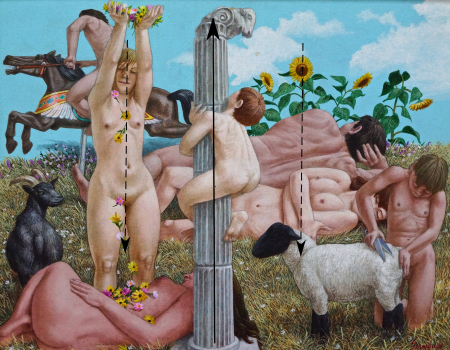
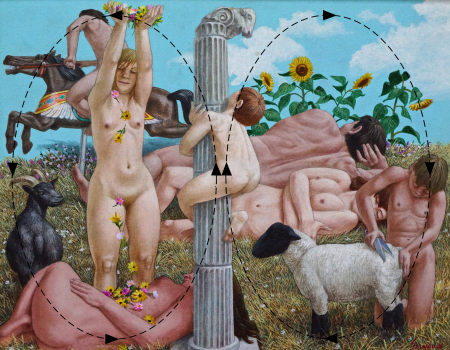
Fig. 1 Fig. 2
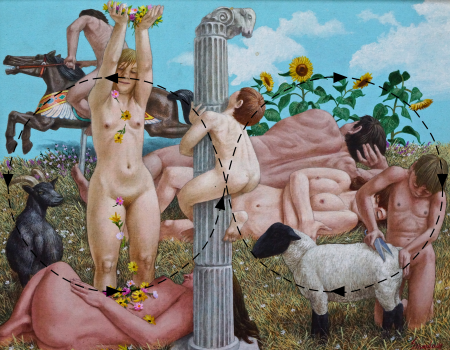
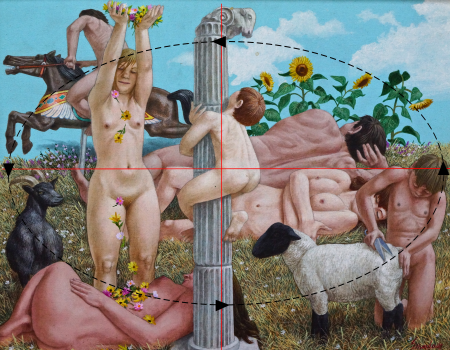
Fig. 3 Fig. 4
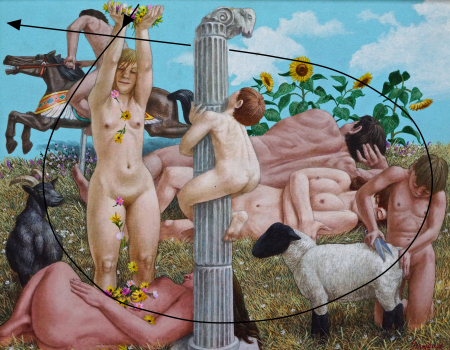
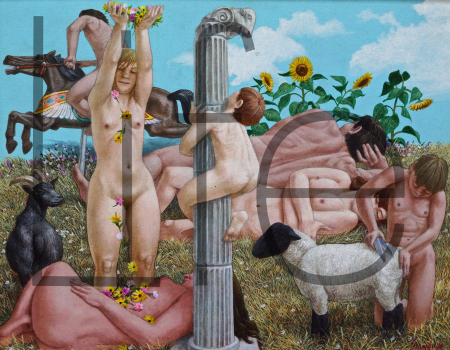
Fig. 5 Fig. 6
The following referencial material is a work in progress. Feel free to explore the links below until this interpretation is completed........
"Ruins of Rome"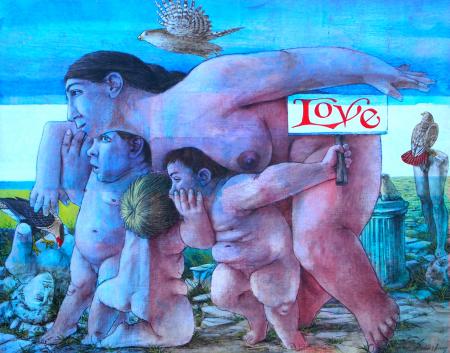
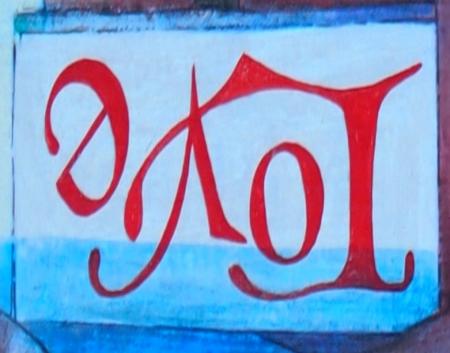
This composition is another example of the artist's mysterious style of inserting hidden messages in some of his work, similar to how the Beatles did in some of their songs and album covers at the end of the 1960's. Notice the positions of the four "characters" in both the painting and its detail, inverted on the right. Each letter stands for a member of his original family. His deceased father and brother are represented as ruins. See Interpreting "Ruins of Rome".
"September" and its carousel ride also includes the theme of sensual youth, when young love blossoms over the summer (see Interpreting "August") and enjoys a final celebration at the carnival over Labor Day weekend before returning to school.
It was at the end of the 1967 Summer of Love when Vincent painted “September”, so before we leave summer for good in his “months of the year” series , a final psychedelic era celebration of nubile feminine form is in order:
"Time of the Season" - a song by The Zombies, featured on their album Odessey and Oracle, was recorded at the Beatle's Abbey Road Studios in August 1967:
https://www.youtube.com/watch?v=qzpPy9hJYA8 (skip the ad and view full screen)
Vincent Smarkusz was in his forties and the prime of his life as an artist when he painted "September", during the height of the New-Age movement of the 1960's. The following song was recorded by the American folk rock band The Byrds in 1965 when it became an international hit. Vincent's own use of bird imagery as symbolim for spirituality enamored him to this group of young musicians as they set Bible verse to music. The lyrics were adapted word-for-word from Chapter 3 of the Book of Ecclesiastes.
"Turn! Turn! Turn! (to Everything There Is a Season)" by the Byrds:
https://www.youtube.com/watch?v=pKP4cfU28vM
To Everything There is a Season - Ecclesiastes 3:1-8
1 To every thing there is a season, and a time to every purpose under heaven:
2 A time to be born, and a time to die; a time to plant, and a time to reap;
3 A time to kill, and a time to heal; a time to destroy, and a time to create;
4 A time to weep, and a time to laugh; a time to mourn, and a time to dance;
5 A time to cast away stones, and a time to gather stones together; a time to embrace, and a time to refrain from embracing;
6 A time to gain, and a time to lose; a time to keep, and a time to give;
7 A time to rend, and a time to sew; a time to be silent, and a time to speak;
8 A time to love, and a time to hate; a time of war, and a time of peace.
And....for those who love CAROUSELS:
https://www.youtube.com/watch?v=iDWCb3qP5Tc
https://www.youtube.com/watch?v=0Zf-zi4ubI4

